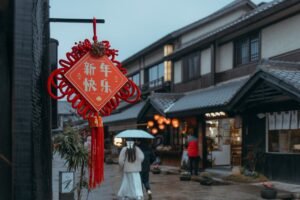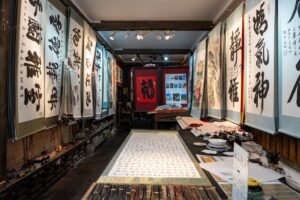Chinese cinema has a rich and diverse history that dates back to the early 20th century. From its humble beginnings in silent films to its current status as a global powerhouse, Chinese cinema has made a significant impact on the world of film. In order to fully appreciate and understand Chinese cinema, it is important to familiarize oneself with the terminology and phrases commonly used in this industry.
Understanding Chinese film terminology is crucial for several reasons. Firstly, it allows viewers to fully comprehend the nuances and intricacies of Chinese films. Many Chinese films are deeply rooted in Chinese culture and history, and without a basic understanding of the language and terminology, much of the meaning and symbolism can be lost. Additionally, being familiar with Chinese film terminology allows viewers to engage in meaningful discussions and analysis of these films, further enriching their viewing experience.
Table of Contents
ToggleKey Takeaways
- Chinese cinema has a rich history and unique vocabulary that is important to understand.
- Essential terms for blockbuster films include “box office,” “special effects,” and “sequel.”
- Indie film lingo includes terms like “low budget,” “arthouse,” and “auteur.”
- Understanding film terminology is crucial for effective communication and analysis in the industry.
- Behind the scenes vocabulary includes terms like “gaffer,” “boom operator,” and “best boy.”
Essential Terms for Blockbuster Films
Blockbuster films are big-budget productions that are intended to attract a large audience and generate significant revenue. These films often feature high-profile actors, elaborate special effects, and grandiose storylines. In Chinese cinema, there are several terms commonly used to describe blockbuster films.
One such term is “大片” (dà piàn), which translates to “big film” or “blockbuster.” This term is used to describe films that have a large budget, extensive marketing campaigns, and high production values. Another term commonly used in Chinese blockbuster films is “特效” (tè xiào), which means “special effects.” Special effects play a crucial role in many blockbuster films, as they help create visually stunning scenes and enhance the overall cinematic experience.
Some popular examples of Chinese blockbuster films include “Wolf Warrior 2,” “The Wandering Earth,” and “Ne Zha.” These films have not only achieved great success domestically but have also gained international recognition for their high-quality production values and captivating storytelling.
Understanding Indie Film Lingo
While blockbuster films dominate the mainstream Chinese cinema industry, there is also a thriving independent film scene in China. Indie films, or independent films, are typically low-budget productions that are often characterized by their artistic and experimental nature. Understanding the terminology used in Chinese indie films is essential for appreciating and analyzing these unique works of art.
One term commonly used in Chinese indie films is “独立电影” (dú lì diàn yǐng), which translates to “independent film.” This term refers to films that are produced outside of the mainstream studio system and often explore unconventional themes and storytelling techniques. Another term frequently used in Chinese indie films is “实验电影” (shí yàn diàn yǐng), which means “experimental film.” Experimental films push the boundaries of traditional filmmaking and often challenge viewers’ expectations.
Some popular examples of Chinese indie films include “An Elephant Sitting Still,” “Kaili Blues,” and “A Touch of Sin.” These films have garnered critical acclaim both domestically and internationally for their unique storytelling approaches and thought-provoking themes.
The Importance of Film Terminology
| Term | Definition | Importance |
|---|---|---|
| Close-up | A shot in which the camera is positioned very close to the subject, often showing only a part of the face or body. | Helps to convey emotions and expressions of the character, and can also be used to highlight important details or objects. |
| Montage | A sequence of shots that are edited together to create a specific effect or convey a particular idea or emotion. | Allows filmmakers to compress time, convey complex ideas or emotions, and create a sense of rhythm or momentum. |
| Diegetic sound | Sound that originates from within the world of the film, such as dialogue, music, or sound effects that the characters can hear. | Helps to create a sense of realism and immersion, and can also be used to convey important information or emotions. |
| Tracking shot | A shot in which the camera moves along with the action, often following a character or object as they move through the scene. | Allows filmmakers to create a sense of movement and momentum, and can also be used to highlight important details or objects. |
| Jump cut | A cut in which two shots of the same subject are taken from slightly different camera positions, creating a jarring effect. | Can be used to create a sense of disorientation or unease, and can also be used to compress time or create a sense of urgency. |
Film terminology plays a crucial role in enhancing the viewing experience of Chinese cinema. By understanding the language and phrases commonly used in this industry, viewers can fully appreciate the nuances and complexities of Chinese films. Film terminology allows viewers to delve deeper into the themes, symbolism, and cultural references present in these films, enriching their understanding and enjoyment.
Film terminology also plays a vital role in film production and distribution. Filmmakers rely on a shared vocabulary to communicate their vision to cast and crew members. By using specific terms and phrases, filmmakers can effectively convey their creative ideas and ensure that everyone involved in the production process is on the same page.
In terms of distribution, film terminology helps categorize and market films to specific audiences. By using genre-specific terms and expressions, distributors can target the right audience and generate interest in a particular film. This not only benefits the filmmakers but also allows viewers to discover films that align with their interests and preferences.
Behind the Scenes Vocabulary
Behind the scenes, there is a whole world of terminology used in film production. From pre-production to post-production, understanding these terms can provide valuable insights into the filmmaking process. Here are some common terms used in Chinese film production:
1. “制片” (zhì piàn) – Producer: The person responsible for overseeing the entire production process, from securing funding to managing the logistics of the shoot.
2. “导演” (dǎo yǎn) – Director: The creative force behind the film who guides the actors and crew to bring the vision to life.
3. “剧本” (jù běn) – Script: The written document that outlines the story, dialogue, and actions of a film.
4. “摄影师” (shè yǐng shī) – Cinematographer: The person in charge of capturing the visual elements of a film, including lighting, camera angles, and composition.
5. “剪辑” (jiǎn jí) – Editing: The process of selecting and arranging footage to create a cohesive narrative.
6. “音效” (yīn xiào) – Sound effects: The artificial sounds added to a film to enhance the auditory experience.
7. “配乐” (pèi yuè) – Film score: The original music composed specifically for a film to enhance its emotional impact.
Understanding these terms can provide viewers with a deeper appreciation for the technical aspects of filmmaking and how they contribute to the overall cinematic experience.
Genre-Specific Expressions

Different film genres often have their own specific terms and expressions. These terms help categorize films and provide viewers with a better understanding of what to expect. Here are some common terms used in different film genres in Chinese cinema:
1. “武侠” (wǔ xiá) – Martial arts: This genre focuses on martial arts and often features elaborate fight scenes and acrobatic stunts.
2. “喜剧” (xǐ jù) – Comedy: Films in this genre aim to entertain and make audiences laugh through humorous situations and witty dialogue.
3. “爱情” (ài qíng) – Romance: Romance films explore the complexities of love and relationships, often featuring themes of passion, longing, and heartbreak.
4. “科幻” (kē huàn) – Science fiction: Science fiction films transport viewers to futuristic worlds and often explore themes of technology, space exploration, and the human condition.
5. “恐怖” (kǒng bù) – Horror: Horror films aim to frighten and unsettle viewers through suspenseful storytelling, supernatural elements, and graphic violence.
6. “历史” (lì shǐ) – Historical: Historical films are set in a specific time period and often depict real events or historical figures.
Understanding these genre-specific terms allows viewers to navigate the vast landscape of Chinese cinema and discover films that align with their interests.
Historical References in Chinese Cinema
Chinese cinema often reflects the rich history and culture of China. Many films draw inspiration from historical events, figures, and traditions, incorporating them into their storytelling. Understanding these historical references is essential for fully appreciating the depth and significance of Chinese films.
One example of a historical reference in Chinese cinema is the use of traditional Chinese opera. Traditional Chinese opera has a long history and is deeply rooted in Chinese culture. Many films incorporate elements of Chinese opera, such as costumes, makeup, and musical styles, to pay homage to this traditional art form.
Another example is the portrayal of historical figures and events. Films like “The Last Emperor” and “Red Cliff” depict significant moments in Chinese history, allowing viewers to gain a deeper understanding of the country’s past.
By recognizing these historical references, viewers can engage in meaningful discussions about the cultural significance of Chinese films and how they contribute to the preservation and promotion of Chinese history and traditions.
The Art of Film Critique
Film critique plays a vital role in Chinese cinema. Critics provide valuable insights and analysis of films, helping viewers understand the artistic merits and flaws of a particular work. Understanding the terminology used in film critique allows viewers to engage in meaningful discussions and develop a critical eye when watching Chinese films.
Some common terms used in film critique include:
1. “剧情” (jù qíng) – Plot: The sequence of events that make up the story of a film.
2. “表演” (biǎo yǎn) – Performance: The acting skills and portrayal of characters by the cast.
3. “导演手法” (dǎo yǎn shǒu fǎ) – Directorial techniques: The creative choices made by the director to convey their vision.
4. “摄影” (shè yǐng) – Cinematography: The visual elements of a film, including lighting, camera angles, and composition.
5. “剪辑” (jiǎn jí) – Editing: The arrangement and selection of footage to create a cohesive narrative.
By familiarizing themselves with these terms, viewers can gain a deeper understanding of the technical aspects of filmmaking and develop their own critical perspectives when watching Chinese films.
Expressing Emotion through Film Vocabulary
Film vocabulary plays a crucial role in conveying emotions and creating an immersive cinematic experience. By understanding the language and phrases commonly used to express emotions in Chinese cinema, viewers can fully appreciate the emotional depth and impact of these films.
Some common terms used to express emotions in Chinese cinema include:
1. “悲伤” (bēi shāng) – Sadness: This term is used to describe a feeling of deep sorrow or grief.
2. “喜悦” (xǐ yuè) – Joy: This term is used to describe a feeling of great happiness or delight.
3. “紧张” (jǐn zhāng) – Tension: This term is used to describe a feeling of suspense or anxiety.
4. “震撼” (zhèn hàn) – Shock: This term is used to describe a feeling of intense surprise or disbelief.
By recognizing these emotional expressions, viewers can connect with the characters and storylines on a deeper level, allowing for a more immersive and emotionally resonant viewing experience.
The Future of Chinese Cinema and its Terminology
Chinese cinema has experienced significant growth and success in recent years, both domestically and internationally. As the industry continues to evolve, so too will its terminology. With the rise of streaming platforms and digital distribution, new terms and phrases will emerge to describe the changing landscape of Chinese cinema.
One prediction for the future of Chinese cinema is the continued expansion of international collaborations. Chinese filmmakers are increasingly partnering with international studios and talent, resulting in a fusion of different filmmaking styles and cultural influences. This cross-cultural exchange will likely lead to the development of new terminology that reflects these collaborations.
Another prediction is the increased focus on diverse storytelling and representation. Chinese cinema has traditionally been dominated by mainstream narratives, but there is a growing demand for more inclusive and diverse stories. This shift will likely result in the emergence of new terms and expressions that reflect these changing narratives.
In conclusion, understanding Chinese film terminology is essential for fully appreciating and analyzing Chinese cinema. From blockbuster films to indie productions, film terminology enhances the viewing experience and allows viewers to engage in meaningful discussions about these films. As Chinese cinema continues to grow and evolve, so too will its terminology, reflecting the changing landscape of this dynamic industry.








